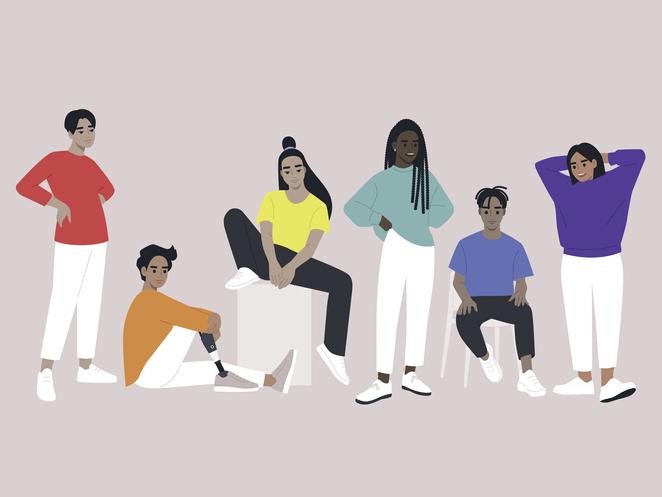
Creating an environment where staff and students feel comfortable sharing their pronouns
Using the correct pronouns is a key part of respectful communication – so where do we begin with creating a university environment where sharing pronouns becomes a natural part of our workplace culture?
Sharing our pronouns is one way in which staff, students and visitors can feel supported and welcome within our higher education institutions.
Pronouns are words that refer to a person or an object in place of their name. These can directly refer to other people or ourselves (for example, I/he/she/they) or to someone’s ownership of something (such as my/his/her/their).
Because pronouns are related to someone’s identity, using the correct ones is essential for respectful communication with and about others. We often talk about the importance of respecting someone’s pronouns when advocating for the rights and inclusion of trans and non-binary people, but everyone has their own pronouns and the wish to be acknowledged for who they are. Sharing your pronouns shows that you wouldn’t expect other people to know how you identify based on your name or appearance, and that you won’t assume others’ either.
- Collection: The importance of getting students’ names right
- What LGBTIQ+ allyship means in academia
- Embracing inclusivity with ‘y’all’: why this pronoun deserves a fresh look
Using pronouns is vital for creating an inclusive environment. A 2020 paper in the International Journal of Environmental Research and Public Health found that social interactions in which a person is addressed by their correct name and pronouns are widely recognised as a basic and yet critical aspect of gender affirmation. The paper also stated that “addressing someone by the wrong name or misgendering them through use of incorrect pronouns can feel disrespectful, harmful and even unsafe to the person being misgendered, since misgendering results in marginalisation and communicates that a person’s identity is not being seen or respected”.
So it’s important to get it right.
It’s also increasingly common to proactively share pronouns; a study from Cornell University found that discussions about pronouns are becoming ubiquitous at schools and workplaces. It also found that, in the online sphere, the number of users who openly shared their pronouns in their Twitter bios rose by 33 per cent from 2020 to 2021.
So where do we begin with creating an environment in which sharing pronouns becomes a natural part of our workplace culture? Here are some tips to get started.
Develop an email signature template
A good place to start is developing an organisation template for email signatures, making it easy for all staff to show their pronouns clearly, right next to their names and before their job titles.
Leverage your internal systems
Systems and software you already use in your institution might allow you to add your pronouns, such as Microsoft 365, Zoom and Slack. These options are often hidden by default, so it’s worth signposting them in your internal communications.
Get comfortable introducing yourself with your pronouns
Get into the habit of introducing yourself to new people or in new settings with your pronouns. It might feel a little awkward at first, especially if you feel as if your pronouns are “obvious” from your gender presentation – but practice will help. It’s important to avoid assuming that people’s presentation determines the pronouns they use. Your actions could empower someone who might be apprehensive about sharing theirs to do so.
Find opportunities to address myths around pronouns
See where you can dispel the myths around pronouns and their usage. Perhaps it’s a short intranet story or social media campaign on International Pronouns Day to bust the myths surrounding pronouns, such as: “Only trans and non-binary people should share their pronouns”, “Your pronouns are permanent”, “You can’t refer to a singular person as ‘they/them’” and “I don’t have pronouns”. This could alleviate reservations that members of your communities might have about adding their pronouns to the platforms you use or introducing themselves with them.
Avoid using the term ‘preferred pronouns’
While some people’s pronouns may change, and some people use more than one set of pronouns, using the phrase “preferred pronouns” gives the impression that pronouns other than the ones that have been specified are acceptable to use – which isn’t the case.
Provide pronoun badges for staff and students
Pronoun badges for staff and students to put on their lanyards or clothes are a way for pronouns to be respected without the need to ask questions. Instead of only having options for he/him, she/her and they/them, consider offering customisable badges to allow for other pronouns – whether they’re made to order or plain so they can be written on.
Develop a pronoun guide
Having a dedicated guide to pronoun usage for staff and students can build confidence for those who have questions about pronouns. Guidance can include practical steps for adding your pronouns to the platforms used at your institution, how to respect other people’s pronouns and what to do if you make a mistake or if you’re unsure how to address someone. A tip would be that if you make a mistake and use the wrong pronouns for someone, say sorry and correct yourself before moving on: “He said, sorry, they said that…” Do not make a big deal out of it. If you keep making mistakes, it might help to practise using the correct pronouns for the person as often as you can.
Remember that not everyone will be comfortable with sharing their pronouns, and doing so shouldn’t be compulsory. The aim is to create an environment where people are confident and comfortable in sharing their pronouns and expressing their gender identities by normalising the chances to do so.
Kat Smith is a communications executive at University of the Arts London (UAL).
If you would like advice and insight from academics and university staff delivered direct to your inbox each week, sign up for the Campus newsletter.




